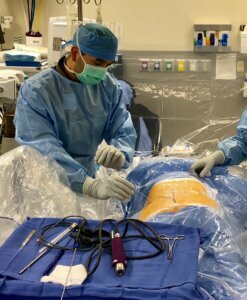Rolling out of bed and walking 10 steps to begin a workday may be setting people up to developing neck and back pain, according to a Northern Virginia spinal surgeon who has tips to help keep those working from home healthy.
“We are seeing an uptick in those injuries in and of themselves based on the work from home economy,” said Dr. Colin Haines, director of research at The Virginia Spine Institute in Reston.
“The working-from-home injuries really have been sustained by, oftentimes, people being hunched forward at the neck, or sitting too long; not warming up, not getting the proper exercise,” Haines said.
How can you prevent developing these types of injuries? Begin your day by warming up.

“We’re not walking to the Metro; we’re not even walking to the car, and not necessarily getting that hot shower,” he said. “So, loosen up the muscles with some gentle walking, some jumping jacks, just something to get the blood flowing is fantastic.”
Stretching is good, too.
Do neck circles: bending your head to the left, right, front and back, holding each position for 10 seconds. And stretch your back.
“Bend over at the waist, try to touch your toes, hold for 10, lean backwards to the point where you start feeling some resistances and do that for a count of 10 as well,” Haines said.
And do you know about “tech neck?”
“The term we have in the business called ‘tech neck’ is that people are bending their arms; they’re looking at their phones; they’re hunching forward at the neck, and that predisposes people to neck pain,” Haines said.
Also, don’t slouch.
“We have to make sure we maintain good posture in both our neck, thoracic spine and low back,” Haines said. That includes when you’re sitting, talking on the phone and using the computer.
Phones and computer screens should be read at eye level. While sitting, your feet should be flat on the floor shoulder-width apart, knees bent 90 degrees or a little less, also use a thin pillow or small, rolled-up towel for lumbar support. Shoulders should be back and relaxed.
Taking breaks by standing up and walking around are also recommended to give the discs in your spine a break from the strain of sitting.
What about your arms and hands?
When you’re typing on a keyboard, it is ideal to keep the wrist not too flexed, not too extended and in a normal, neutral resting position but straight.
Arms should be bent at the elbow about 90 degrees. When you bend your elbows for too long in a very flexed position, you risk injuring the ulnar nerve in your elbow that’s commonly known as the funny bone.
“A lot of patients that I see, they come to the office thinking they have a disc herniation in their neck and radiating nerve pain from the neck. But it actually turns out, it’s coming from the elbow,” Haines said.
When does pain signal you need professional help?
If you begin to develop neck or back pain, Haines said early detection is important.
The time to consult a spine specialist is if the pain or discomfort affects your functionality — if you’re not able to pick up your child, for example, or even go for a walk outside.








